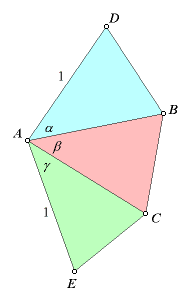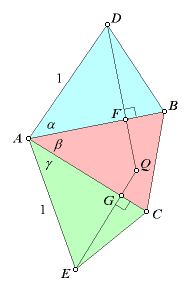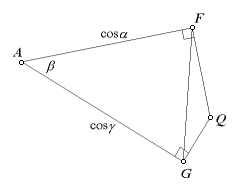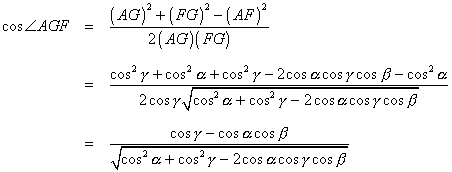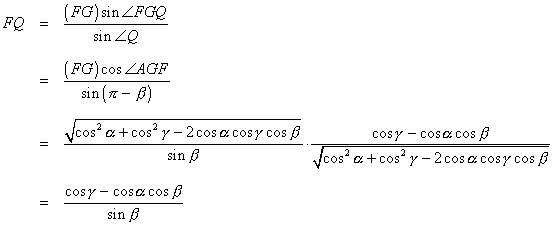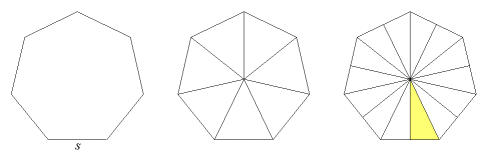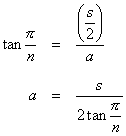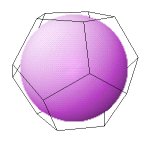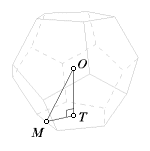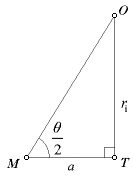Formula Derivations for PolyhedraThe Whistler Alley pages addressing Platonic solids make repeated use of several formulas. Those formulas and their derivations are explained more thoroughly below. 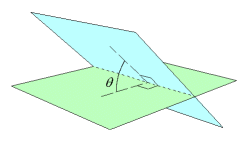
The Dihedral AngleA dihedral angle is the angle of intersection of two planes. It is the measure of an angle having its vertex on the intersecting edge and one side in each of the planes. The sides of the angle are perpendicular to the intersecting edge. In the context of polyhedra, a dihedral angle is the angle of intersection of two adjacent faces. For each of the Platonic solids, there is only one dihedral angle, because all pairs of adjacent faces intersect at the same angle.
For this example, the dihedral angle at edge AB will be derived. Lay it back out into a flat net again. As the faces are folded, the vertex at point D revolves on axis AB and meets point P. This means that points D, P, and Q lie in a plane perpendicular to line AB. It follows that point Q lies on a line through D, perpendicular to AB. By the same reasoning, Q lies on a line through E, perpendicular to AC.
In triangle AFG, use the law of cosines to solve for FG.
Now, find cos∠AGF.
Use the law of sines to find FQ.
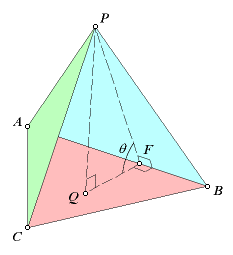
Going back to the folded faces, we see that FP and FQ are both perpendicular to AB, so the angle labeled θ is the dihedral angle. From the right triangle PQF, we get this:
Other CasesCertain other cases should be addressed. Up at the top, it is given that α and γ are acute. The first version of this derivation did not have that condition. Twelve years later, an alert reader pointed out that the substitutions Another issue arises in the middle. Although there is no problem with the final formula, some of the intermediate expressions may have division by zero. This occurs where one or more of the polygon angles are right angles. Such a case is not at all unusual where building polyhedra with regular polygon faces. Note that the final form of the formula involves a denominator that cannot possibly be zero. This case still must be proved separately (by someone else). The formula applies only to cases in which exactly three faces meet at a vertex. There can be no general formula for a case in which more than three faces meet, because those faces by themselves would not form a rigid structure. The Apothem, Polygon Area, and Surface AreaGiven enough dimensions, it is possible to compute the area of any polygon, because the polygon can be dissected into triangles and the elementary triangle area formula can then be applied. For any regular polygon, the area can be computed from the side length alone. Consider the regular polygon below, having side length s. It is a heptagon (having 7 sides), but since we want to derive a general formula, let us call it an
 
Take out one of the right triangles (the yellow one) and look at it closely. Its base is s/2. The measure of the top vertex angle is π/n because it is a full circle divided by 2n. The height is a. This is the apothem of the
That gives us the height of the right triangle, which leads us to its area.
There are 2n of those triangles in the
For a Platonic solid, all of the faces are congruent regular
Inradius and CircumradiusThe inradius of a solid is the radius of the inscribed sphere. All platonic solids have an inscribed sphere. Other polyhedra generally do not.
In these illustrations, the solid being used is a dodecahedron, but the concepts and the formulas apply to all Platonic solids. Consider triangle OTM. Point O is the center of the solid. Point T is the center of the base, which is also the point where the inscribed sphere is tangent to that face. Point M is the midpoint of one of the base edges. It is clear that line segment OM bisects a dihedral angle, so ∠OMT = θ/2, one-half of a dihedral angle. It should also be clear that ∠OTM is a right angle. These last two statements follow from the symmetry of the solid. What we have now is a right triangle with one know side and one known acute angle. A formula for the inradius, ri, follows.
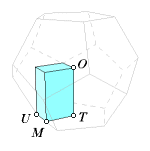
The circumradius is the radius of the circumscribed sphere. It is the distance from the center to a vertex. All platonic solids have a circumradius. Continuing with the same dodecahedron example, let point U be a vertex on the same edge that point M occupies. The circumradius is OU. Points O and U are also opposite vertices of the rectangular prism shown here.
Volume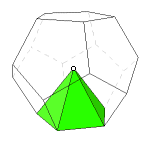
For a general formula for the volume of a Platonic solid, picture a pyramid built on one face, with the center of the Platonic solid as the apex of the pyramid. For the volume of the pyramid, we need its base area and height. Both of those values have already been computed. The base area is the area of a single face of the Platonic solid, and the height is the inradius of the Platonic solid.
In the same way, a pyramid can be built on every face. The pyramids would be congruent, and together, they would fill the solid. For the total volume (V), multiply the pyramid volume by f, the number of faces in the Platonic solid.
In this simplified formula, the volume is expressed in terms of the surface area and inradius. Last update: January 21, 2016 ... Paul Kunkel whistling@whistleralley.com For email to reach me, the word geometry must appear in the body of the message. |
